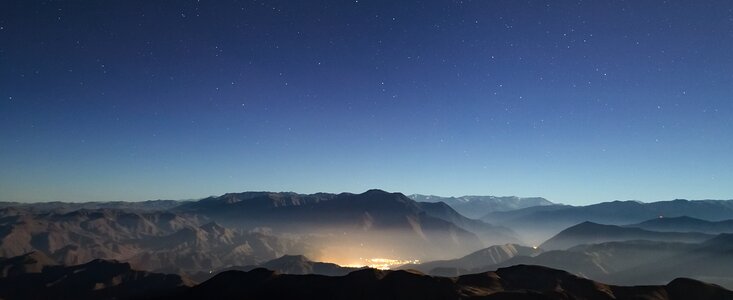Protecting Dark Skies in Arizona
The most impactful near-term effort to protect Kitt Peak National Observatory’s pristine dark skies is updates to the Pima County/City of Tucson Outdoor Lighting Code. Following that, there will need to be a concerted effort by dark-sky advocates to make sure the new provisions meet our needs to the greatest degree possible.
The Arizona Astronomy Consortium (AzAC), an advocacy organization of which NOIRLab is a member, has been engaged with advocates in Metro Phoenix to stop the conversion of conventionally illuminated billboards to digital LED billboards. An amendment to the Maricopa County statute will allow digital billboards along all the freeways and major arteries in the unincorporated county, and will allow the company that wrote the bill to convert their own boards. Maricopa County is also working on its decadal transportation plan, and the AzAC has been providing input on lighting issues.
A potential issue for Kitt Peak National Observatory relates to where the State will decide to put the I-11 corridor. If it goes on the west side of the Tucson mountains, there may be long illuminated stretches of freeway with a line of sight to the summit.
Sky measurements over NOIRLab's three summits showing the level of light pollution.
Protecting Dark Skies in Chile
Chile’s vast network of professional and tourist observatories depends on the pristine darkness of the skies to conduct their world-class research and public appreciation of the sky. Chile’s night sky, certainly in the Coquimbo and Atacama regions, is one of the very best and darkest in the world, and it is this quality that has attracted so many large observatories to Chile’s mountaintops.
Light pollution from nearby cities (La Serena, Coquimbo, Ovalle, Andacollo, and Vicuña) has been a concern over the last decade, owing to the rapid growth in population and development which this region of Chile has undergone. AURA and the Cerro Tololo Inter-American Observatory have undertaken an aggressive campaign — which began in December 1993 — both locally in the surrounding cities and at the Chilean congressional level, to alert the Chilean public and governing agencies to these concerns.
In Chile, NOIRLab is actively working with other AURA staff, the Oficina de Protección de la Calidad del Cielo del Norte de Chile, University of La Serena, Fundación Cielos de Chile, and local authorities as scientific advisors, monitoring the sky brightness resulting from the use of artificial lighting at night. The quantitative data helps determine where it would be appropriate to correct or update lighting installations, especially in locations where light pollution control is highly important, such as those near Cerro Tololo and Cerro Pachón. In addition, NOIRLab collaborates on education initiatives regarding the importance of dark skies through various outreach events and campaigns.
The priorities and timing of our efforts in Chile have concentrated in the areas most likely to threaten Pachón and Tololo in the decades to come — beginning with nearby Vicuña in 1993, and increasing the relative emphasis on La Serena and Coquimbo once maps from the First World Atlas of the Artificial Night Sky Brightness became available.
Protecting Dark Skies in Hawai‘i
In contrast to Chile and Arizona, visible-wavelength light pollution on Maunakea is small, only 2–3% of the total night sky brightness, and therefore changes will be quite small, even over several years. Advocacy and action on light pollution in Hawai‘i on behalf of the Maunakea Observatories is led by the University of Hawai‘i. The University has good contacts with the County and State governments and has a working relationship with the US Army’s Pohakuloa Training Area, the nearest source of light pollution. NOIRLab supports them with data and other assistance as requested and will contribute to display material at the Imiloa Astronomy Center in Hilo or the Visitor Center at the mid-level facility at Hale Pohaku on Maunakea. Videos and images from the Gemini North cloud cameras are quite effective at illustrating the issues. The common Maunakea site monitoring equipment will need to be replaced by 2028, and NOIRLab will advocate for the use of standard Site Quality Cameras that are used in Chile and Arizona.
Educational Light Pollution Programs
NOIRLab and its predecessors started the international citizen-science program Globe at Night in 2006 and it has run continuously since then. Since 2006, more than 250,000 people have contributed to a global light pollution measurement campaign simply by looking up at the stars they can see in selected constellations. While not a scientific survey, Globe at Night helps spur people to be more aware of light pollution through citizen science.
NOIRLab oversaw the International Year of Astronomy cornerstone on Dark Skies Awareness in 2009. A lot of legacy programs came out of that effort, carried out by many people all over the world. NOIRLab also oversaw a project supported by the IAU Office of Astronomy for Development in 2013 on Dark Skies Outreach to Sub-Saharan Africa, and oversaw the International Year of Light theme of Dark Skies Awareness in 2015. The Quality Lighting Teaching Kit was awarded top place for funding from the IAU to create, build, and distribute the kit around the world. NOIRLab oversaw the IAU 100 project on Turn on the Night kit and co-organized the Dark-Skies Ambassadors program for the centenary celebration of the IAU.

